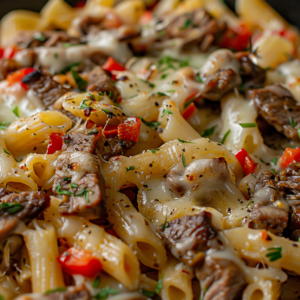Introduction:
Indulge in the savory goodness of a classic Philly cheesesteak with a modern twist in our delectable Philly Cheesesteak Pasta recipe. This fusion dish combines the iconic flavors of thinly sliced steak, caramelized onions, bell peppers, and melted cheese with tender pasta, creating a mouthwatering dish that will satisfy your comfort food cravings. In this article, we’ll guide you through the simple steps to create this delicious pasta dish at home, along with tips for serving and storing it for optimal enjoyment.
Ingredients:
- 1 lb penne pasta
- 1 tablespoon olive oil
- 1 lb thinly sliced beef steak
- 1 large onion, sliced
- 1 green bell pepper, sliced
- 2 cloves garlic, minced
- 1 teaspoon salt
- 1/2 teaspoon black pepper
- 2 tablespoons all-purpose flour
- 2 cups beef broth
- 1 cup heavy cream
- 2 cups shredded provolone cheese
- 1/2 cup grated Parmesan cheese
Directions:

- Cook the penne pasta according to package directions until al dente, then drain and set aside.
- Heat the olive oil in a large skillet over medium-high heat. Add the steak, onion, bell pepper, and garlic. Cook, stirring frequently, until the steak is browned and vegetables are tender, about 6-8 minutes.
- Sprinkle the flour over the steak mixture and stir to combine. Cook for 1 minute.
- Gradually pour in the beef broth and bring to a simmer. Add the heavy cream and continue to cook, stirring, until the sauce thickens, about 3-4 minutes.
- Remove from heat and stir in the cooked pasta, 1 cup of provolone, and the Parmesan cheese. Transfer the mixture to a baking dish.
- Top with the remaining provolone cheese and bake in a preheated 375°F (190°C) oven until the cheese is bubbly and golden, about 20-25 minutes.
- Serve hot garnished with parsley if desired.
- Prep Time: 15 minutes | Cooking Time: 35 minutes | Total Time: 50 minutes
- Kcal: 610 kcal | Servings: 6 servings
Serving Tips:
- Garnish and Presentation: Before serving, garnish the Philly Cheesesteak Pasta with freshly chopped parsley for a pop of color and added freshness. Arrange the pasta neatly on serving plates or in a large serving dish for an attractive presentation.
- Side Dishes: Consider serving the pasta alongside complementary side dishes such as garlic bread, a crisp green salad, or steamed vegetables to round out the meal and add variety to the dining experience.
- Family-Style Serving: For a casual gathering or family meal, place the skillet or serving dish of Philly Cheesesteak Pasta in the center of the table and allow guests to help themselves, creating an interactive and communal dining experience.
- Customization: Encourage guests to customize their pasta with additional toppings such as grated Parmesan cheese, red pepper flakes for heat, or a drizzle of balsamic glaze for added flavor complexity.
Storage Tips:
- Refrigeration: Store any leftover Philly Cheesesteak Pasta in an airtight container or resealable plastic bag in the refrigerator for up to 3 days. Ensure the pasta is completely cooled before transferring it to the container to prevent condensation and maintain freshness.
- Reheating: When reheating refrigerated pasta, add a splash of beef broth or water to the skillet or microwave-safe dish to prevent the pasta from drying out. Gently reheat the pasta over medium heat on the stovetop or in the microwave until heated through, stirring occasionally to distribute heat evenly.
- Portioning for Individual Meals: Consider portioning the leftover pasta into individual meal-sized containers before refrigerating. This makes it easier to grab a single serving for quick lunches or dinners throughout the week, reducing food waste and streamlining meal preparation.
- Freezing: While pasta dishes with creamy sauces like Alfredo may not freeze well, Philly Cheesesteak Pasta can be frozen for longer-term storage. Portion the cooled pasta into freezer-safe containers or resealable plastic bags, leaving some space for expansion, and store in the freezer for up to 3 months. Thaw overnight in the refrigerator before reheating as directed.
FAQs:
- Can I Use a Different Type of Pasta for This Recipe? Yes, you can customize the recipe by using your favorite type of pasta. While fettuccine or penne are commonly used, you can also try rigatoni, spaghetti, or even gluten-free pasta if preferred.
- Can I Substitute the Steak with Another Protein? Absolutely! If you prefer, you can substitute the steak with sliced chicken breast, ground beef, or even mushrooms for a vegetarian option. Adjust the cooking time and seasoning accordingly to suit the chosen protein.
- What Type of Cheese is Best for Melting Over the Pasta? Provolone and mozzarella cheese are popular choices for melting over Philly Cheesesteak Pasta due to their creamy texture and mild flavor. However, you can experiment with other melting cheeses such as cheddar, Monterey Jack, or Swiss for different flavor profiles.
- How Can I Make This Recipe Spicier? To add a kick of heat to the dish, you can incorporate sliced jalapeños, crushed red pepper flakes, or a drizzle of hot sauce during the cooking process. Adjust the amount according to your preferred level of spiciness.
- Can I Prepare This Dish Ahead of Time for a Party or Gathering? Yes, you can prepare Philly Cheesesteak Pasta ahead of time and reheat it just before serving. Follow the recipe instructions up to the point of adding the cheese, then allow the dish to cool completely before refrigerating. Reheat gently on the stovetop or in the oven, adding the cheese just before serving for optimal freshness and flavor.
Conclusion:
With its bold flavors and comforting appeal, Philly Cheesesteak Pasta is sure to become a new favorite in your recipe repertoire. Whether enjoyed for a cozy dinner at home or served at a casual gathering with friends and family, this fusion dish offers a delicious twist on two beloved classics. Follow our simple recipe and savor the delightful flavors of Philly cheesesteak in every pasta-filled bite!

